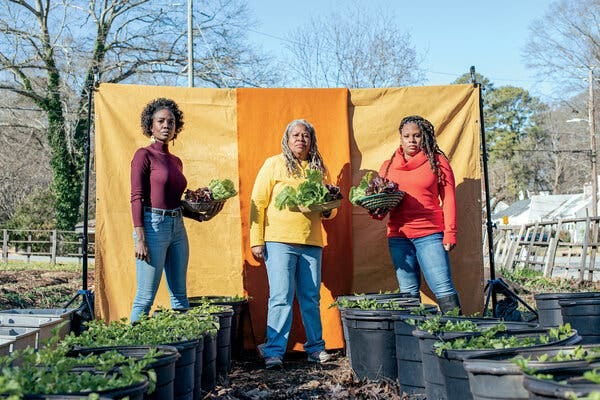Dada Reads_022721
Articles: Liz Pelly on streaming, Ligaya Mishan on food activism, Paula Mejía on "Hache" Carrillo, Laura Snapes on GenZ songwriters, Safy-Hallan Farah on "sad girls," Jeff Mills' new magazine.
For much of the last few weeks I’ve lived a bit of a schizophrenic existence. On the one hand, I’d been working a project that took me neck-deep into listening to and thinking about Sun Ra , which has meant discarding a lot pf predilections about contemporary society’s regards for age, time and temporality. On the other, I’ve been grading papers and deep in conversations about meaning and context of current pop, which this has meant a lot of Olivia Rodrigo’s “drivers license,” confronting the audio consequences of Sophie’s passing, and, in the past few days, reflecting on Daft Punk’s disappearance. (i.e. a world quite obsessed with age, time and temporality.) It’s made me think how much of the music I engage with reflects my age, which is both natural and, on some level, as it should be; but also alienating to the generalist, younger audience. And while Dad Strain is purposefully not designed as a space to deeply consider many of youth’s machinations—especially since much of cultural media bends to the whims (sonic and technological) that this market segment brings to offer—it was an important reminder to listen to the stories and ideas carried by much younger people, lest one turn to the same type of close-minded f*ckery one rails against. Finding a truthful balance between those two worlds is far more strenuous than sometimes I can imagine, but the exercise has reinforced the need to constantly engage both worlds if the Dada Strain project is to work, and the Next Times are not just a stupid rehash of where we were pre-quarantine. The readings kinda reflect that.

Liz Pelly, “Socialized Streaming” (Real Life 2/16/21) | There’s a lot going on in Liz Pelly’s latest article questioning the economics and ethics of streaming; and if the notion of socializing the entire ecosystem does strike me as an unlikely bridge too far, the call to reimagine the road ahead, and to create small sustainable streaming communities that could actually be funded via local audiences and civic institutions, should be a short-term goal, and is very much within potential reach. “We should conceptualize futures where music is part of the greater ongoing project of freeing art from capitalism. As part of that work, we should think about socializing music streaming. Music is an integral part of the cultural landscape: It brings people together, it provides an outlet, as well as an archive. At best it can reflect the tenor of society at any given moment. It is a public good. What would it look like if we thought about access to music the way we thought about other important forms of culture and information — for example, books? Physical copies of music have long been available at public libraries, but we don’t currently conceptualize universal access to music as a public good, to be managed in the public interest with public funding. We should. Making the public interest a core priority would mean more equitable payment and treatment of musicians and music workers. It also would help to repair some of the more harmful relationships with music that streaming — obsessed with boosting engagement metrics without concern for context — has encouraged and exacerbated. Socialized streaming would not be a fix-all, but it would be a step away from a culture shaped by profit motives and a step toward new logics of listening online. And it could seed paradigm shifts for the way we think about cultural consumption and how we value creative labor….The basic premise of the American Music Library suggests that streaming could be less destructive to society if it were funded and organized differently — that perhaps the problem with streaming isn’t streaming per se, but the predatory industry norms that surround it. ”

Ligaya Mishan, “The Activists Working to Remake the Food System” (T Magazine 2/19/21) | One of the reasons I enjoy reading good food writing is that it always reflects bigger issues at play in late-stage capitalist America and the global markets, whether that be cultural, infrastructural, labor rights, health care, and on and on.. That is very much the case with Ligaya Mishan’s excellent, succinct history of the many layers of food activism in America, its struggles and achievements and purpose, touching on everything from front-line workers in meat plants, to community farmers, to health-food red-lining, to the infrastructural forces at play. It’s not hard to read it and feel like you are encountering the deconstruction of a whole other sector of contemporary society. “Since the 1980s, the primary message of the food movement to reach the broader public has been not a call to arms but rather a vaguely feel-good mantra: to eat more healthily by shopping at the farmers’ market and buying organic, unprocessed, non-mass-market foods. Certainly these strategies help the environment and support small businesses, but this sometimes seems like just a side benefit, with the emphasis on personal wellness, as if the only way to persuade people to ‘vote with their fork’ on behalf of laborers or the planet were by appealing to their self-interest. It points to a tension in food activism between trying to influence individual acts of consumption, in hopes of bringing about incremental change, and taking direct political action. ‘The belief that we will change things through individual market choices is a way of not questioning the market itself,’ says Eric Holt-Giménez, an agroecologist and the former executive director of the Oakland-based think tank Food First. ‘We tend to concentrate on the romantic — the small farmer growing organic vegetables — when all this time we could’ve been fighting for parity and antitrust laws.’”
Paula Mejía, "The Secret Life of H.G. Carrillo" (Rolling Stone 2/11/21) | This multi-layered tale of Hermán Gernán "Hache" Carrillo — a beloved GWU writing professor and author of Latinxidad literature purportedly of Cuban descent, who after his passing from COVID in April 2020 was exposed to be Herman Carroll from Detroit — is a fantastic bit of reporting about a figure who kept his personal history secret to even the people in his life he was most intimate with. Moreover, it dives into questions of identity construction in marginalized communities, of teaching writers that construction (without exposing his own), of hoaxes in academia and literature, and, to the piece’s great credit, it does so with little to no judgement. Carrillo impacted a generation of his students (including Mejia), and his story of masking is not at all like the others. “[W]hen the Post story broke, my grief transformed into something more opaque. Everything he’d ever said was called into question overnight, and his lessons took on confounding new layers. He’s now a focal point in a thorny debate about appropriation, passing, opportunity — and the forces that lead people to embody false racial and ethnic identities….Over the past few months, I’ve grappled both with grieving Hache’s death and the alternate identity that emerged following his absence. So I picked up the phone. Sharing stories with strangers who’d been similarly impacted by him felt cathartic, but also led to more questions. Nearly everyone had a memory or a conversation with Hache that now registered as prophetic, or an insight that shed a light into why he might have willingly chosen to leave behind his life as Herman Carroll and construct a new identity as the Cuban author H.G. Carrillo. Detangling the fact from fiction is not unlike unsnarling a tangle of necklaces; some strands have become permanently fused together. But held up against the Hache people knew and adored, do these fabrications invalidate his influence?”
Laura Snapes, “Big feelings and nowhere to go: how Gen Z reinvented the power ballad” (The Guardian, 2/19/21) // Safy-Hallan Farah, “All Alone in Their White Girl Pain” (Hip To Waste, 8/1/20) | Laura Snapes is among my favorite critics of contemporary popular music, one of the writers I read to wrap my head around mainstream sounds I quite often don’t pursue for myself. The piece she wrote last week using “drivers license” as a jump-off, contextualized—despite what the post-colon subhead would suggest—not simply GenZ and power ballads, but young women singer-songwriters and how they got to their individual and shared perspectives in this musical and historical moment. Whether the subject may be of interest or not, it’s an excellent summation of what is undeniably a trend. One of the great strengths of Snapes’ piece was the bevy of links to other materials that provided more context to her argument. One was to a long essay that Safy-Hallan Farah posted on her Substack in August (if you could remember where we all were back then), which by all accounts went viral. I had not seen it, and it floored me. Beyond simply being a great piece of writing, it was an incredible document of history. insightfully recounting tensions between feminist discourses (some real, some performative) in the pop sphere and on its digital platforms during the late Aughts and through the ‘10s. Many of these tensions were based in race and historic “invisibilization,” others in the careerist climbing of contemporary media, social and otherwise; people invested in heroine narratives and the notion that popular female characteristics could be attributed with political agency and cultural import. Safy’s critique paints a world that was already tenuous before last summer’s protests exposed it as utterly threadbare. And while I, an SWM “old,” fully recognize the level of voyeurism inherent to following discourses of women two generations younger, I also can’t help but think that not recognizing and valuing the insight of these foreign-to-me experiences is how the stereotypes continue to be perpetuated ad nauseam. “[Sad Girl Theory] is deceptively shallow, but to the TLDR masses, it scans as meritorious. I have taken to calling this illusion ‘third wave scam.’ It can take the form of a cultural grift characterized by watered-down modern pop feminism—or a sly rebuke of it. It’s also a soul contract that tethers all the so-called fail-daughters: the boss babes, the Caroline Calloways, the Lenas, the Lanas, together in one big navel-gazing family. Whether the grift is an MLM, a Pinterest course, a cash-grab essay collection, semi-incoherent literary criticism, or a hollow theory propagated by a pretty white girl, the scam would not exist were it not for the leeway their skin color and class affords them to be mediocre, to fail skywards, bolstered by a pedigree that extends back to the inception of the first America. In this America, there is no glass ceiling for them, only an infinite sky. Third wave scam is evidenced, also, in cultural criticism and reportage by white women that reinforce the exclusion of black and brown women. Legacy publications give white women critics ample space and free, unadulterated reign to write about their taste for things like Glossier and So Sad Today, but they exclude women of color from the same cultural production. We don’t get to write about the things we specifically derive pleasure—or pain—from, things that tend to signal a working-class, racialized perspective. It’s telling, for instance, that the poet Warsan Shire was only canonized, despite being the most famous poet to come out of Tumblr, after her worth was validated by a giant cultural figure like Beyoncé, whereas her white girl contemporaries have their hype artificially, and prematurely in many cases, manufactured by white women critics. And through this white, rarified system, a lot of bad thinking is normalized.”

New Magazine Alert! It should come as absolutely no surprise that Detroit’s foremost techno futurist Jeff Mills has started a magazine. There is even something familiar about how Escape Velocity integrates what is, essentially, sponsored content—the “sponsor” being Mills’ own record label, Axis, whose artists are front and center throughout—alongside themes of visionary innovations and philosophical outer limits that the legendary producer/DJ has been pushing in his own work for three decades. Images of the cosmos and Mills’ multi-dimensional live shows, sit next to short articles about asteroids, pulp science fiction and June Tyson (the one-time singer of Sun Ra’s Arkestra), and a long conversation with Finnish artist Juha Penttinen rests beside Jeff’s short interviews with techno musicians such as Terrence Dixon and DVS1 (and which have the feel of familiarity, akin to Art Taylor’s conversations with his jazz colleagues in the great interview book Notes and Tones). My favorite piece is by the excellent Detroit writer Imani Mixon: titled “Affirmation For the Future” (“As we enter the next unresolved moment, we can be sure that we’ve been here before—in the throes of rebellion, in the relentlessness of grief, in the absence of closeness. We made it out, in due time, with intention. Wholly changed and wholly new.”), it is alone worth the download. As a friend said about why Mills/Axis launched Escape Velocity, “If no one’s gonna write about your artist, start a publication that will.” This is not too dissimilar from Dada Strain’s idea of print self-actualization.
Also reading:
Nathaniel Mackey, Bass Cathedral; Arthur Taylor, Notes and Tones; Wanda Coleman, Wicked Enchantment; Nelson George, The Death of Rhythm & Blues; Intermission—Reflections on a Year Of Upheaval




